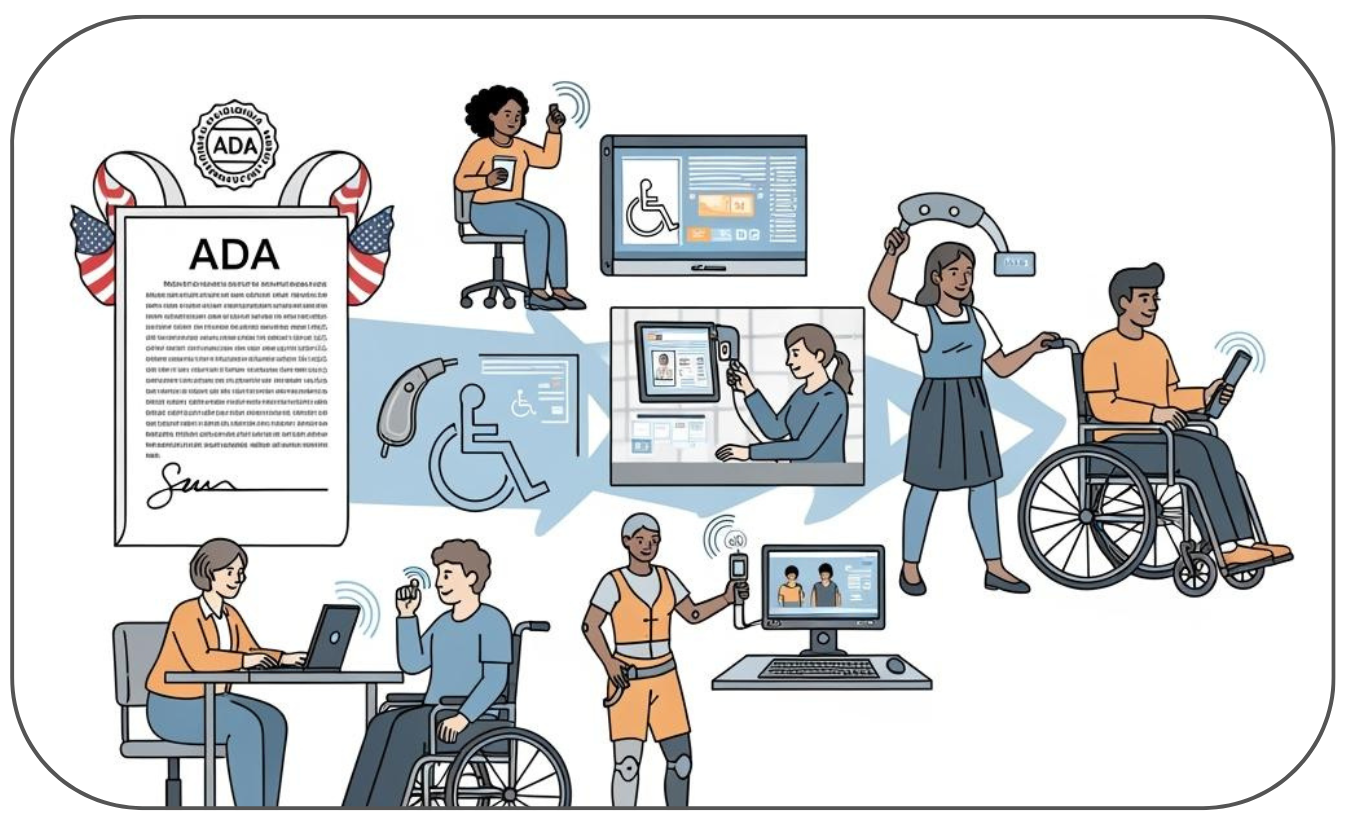The ADA Transformed Technology for Everyone

(AI generated image of many people using examples of assistive technology with a mock-up of the ADA document)
Thirty-five years after its passage, we can see how the Americans with Disabilities Act has done far more than create compliance requirements. The ADA fundamentally transformed how we think about and develop assistive technology, turning what was once a niche specialty into innovations that benefit us all.
From Legal Foundation to Creative Catalyst
When the ADA established its core requirements, it created something powerful: predictable, large-scale demand that made investing in assistive technology not just morally right, but economically viable. Universities needed screen readers for online courses. Employers required workplace accommodations. Public venues sought accessible communication systems. This guaranteed need enabled companies to move beyond uncertain funding cycles toward sustainable product development that serves real human needs.
Perhaps more importantly, the law's broad scope revealed a crucial truth. Serving diverse disability communities required flexible, interoperable systems rather than isolated assistive devices. This realization drove the shift toward universal design principles and cross-platform compatibility that characterizes the technology we rely on today.
Innovation That Serves Everyone
The ADA forced us to reconsider a fundamental assumption: accessibility could no longer be an afterthought. The principle of reasonable accommodation, combined with the reality of diverse and changing needs, transformed universal design from an academic theory into a commercial necessity.
The ADA legitimized disabled people as technology consumers with legal standing, fundamentally shifting power dynamics in product development. Moving beyond charity-model innovation toward user-centered design processes, the disability community's principle of "Nothing about us without us" became essential to creating better technology for everyone.
People with disabilities, older adults, and those managing injuries are now integral to research and development, leading to more intuitive and adaptable technology like customizable interfaces, AI-powered voice and gesture controls, and accessible apps for pain management or rehabilitation.
As our population ages and as injuries remain a common life experience, the ADA-driven focus on accessibility benefits an ever-widening circle of users. Features like voice assistants, fall detection sensors, medication management apps, and simplified interfaces—originally developed for disability contexts—now support people recovering from surgery, managing temporary mobility limitations, or navigating short-term impairments. The distinction between "assistive" and "mainstream" technology continues to blur in ways that enhance all our lives.
Building on Success While Addressing Challenges
The ADA's legacy includes a thriving, innovative assistive technology field that continues to push boundaries. Emerging technologies like artificial intelligence, advanced prosthetics, brain-computer interfaces, and robotics are developing within an accessibility-conscious framework because the ADA established clear expectations. The current AI revolution presents both unprecedented opportunities and familiar challenges around inclusive design from inception rather than retrofitted accessibility.
While mainstream integration represents significant progress, specialized and affordable assistive technology remains an ongoing challenge, especially for those whose needs change due to injury or aging. Innovation has accelerated dramatically, yet gaps persist in areas like cognitive accessibility, intersectional disabilities, and emerging technologies. The ADA's mandate remains a key driver for addressing these challenges and pushing for further progress.
The Enduring Lesson
The ADA proved that enshrining accessibility as a civil right isn't just an ethical imperative - it's a powerful engine for technological innovation that benefits our entire society. By insisting on inclusion, the law ensures that the next 35 years of technological advancement will continue with accessibility as a core value, supporting people with disabilities, older adults, and anyone navigating injury or recovery.
When we recognize assistive technology as a partner in creating a more inclusive world, we understand that the ADA's true gift was showing us how designing for disability creates better solutions for everyone. This partnership between rights and innovation continues to shape a future where technology serves all of us, regardless of ability or circumstance.
References
Berven, H. M., & Blanck, P. D. (1999). Assistive technology patenting trends and the Americans with Disabilities Act. Behavioral Sciences & the Law, 17(1), 47–71.
Know-the-ADA. (2024, September 4). ADA and Assistive Technologies: Past, Present, Future.
Know-the-ADA. (2025, July 1). The ADA in the Era of Artificial Intelligence: Legal Implications.
Wong, A., Mingus, M., & Cokley, R. (2023, May 16). Nothing About Us Without Us: Invest in Disabled Leaders to Advance Equitable Technology for Everyone. Nonprofit Quarterly.
Reply
Content aside
-
1
Likes
- 5 mths agoLast active
- 33Views
-
1
Following
